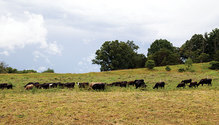The author is a rancher, author, speaker, and consultant with over 40 years of experience in grazing management research, outreach, and practice. He has lived and grazed livestock in hot, humid Missouri and cold, dry Idaho.

Welcome to this first installment of The Pasture Walk. The editors of Hay & Forage Grower have invited me to share my thoughts on pasture and grazing management through 2020. I look forward to this opportunity.
I want to begin this series with the consideration of time management as the most critical piece of the grazing puzzle. Time has always intrigued me, both how we measure it and how we perceive it. As a bit of introduction for those of you who don’t know me, I have been working in the realm of grazing management for over 40 years. Someone introduced me at a conference several years ago and said my career had spanned five decades.
I thought that was nonsense at the time, but then realized I had started doing grazing work in graduate school in the 1970s, and we were already into the 2010s at the time of the introduction. The program moderator was right, but it didn’t really make sense to say that. With the onset of 2020, someone could say my career now spanned six decades. I’m only 63, so did I start as a 4-year-old?
It is all a matter of how we choose to view time, and the aspect of time that I want to discuss here is in the context of the grazing cycle.
What exactly is the grazing cycle?
It is the duration of time from the onset of one grazing event to the onset of the subsequent grazing event. The grazing cycle has two segments of time: the grazing period and the recovery period. In a productive, high-moisture environment, our grazing period might be a single day and recovery period 24 days. In a range setting, we might graze a pasture for 10 days and then allow 14 months of recovery. Those both represent a single grazing cycle.
Limit grazing exposure
Conventional ranch management for generations has largely ignored the critical role of time in pasture and range productivity. The simplest way to explain the importance of time management is this: Mostly bad things happen to plants and soil during the grazing period, while mostly positive things happen during the recovery period. Thus, the fewer days in the year pastures are exposed to grazing, and the more days of recovery, the better the outcome will be.
During the grazing periods, grazing animals primarily remove leaves from the plant. As leaves are removed, photosynthesis is diminished, causing the root system to contract and the direct flow of energy from the plant to beneficial soil microbes to decline or cease altogether. Hoof impact can cause soil compaction. The shorter we make the grazing period, the sooner the pasture can transition to recovery.
During the recovery period, mostly positive things happen to the plants and soil. Photosynthesis increases as long as the plant is still generating new leaf growth. With the renewed flow of energy, the root system expands again and the symbiotic relationships with soil biota resume and accelerate. Recovery must take place during the active growing season. Grazing a pasture throughout the growing season and removing stock in the winter does not constitute recovery.
Consider plant, animal, and soil
From the plant perspective, we want to avoid leaving stock on a pasture once new recovery growth has begun. If new growth is being created using stored carbohydrate energy, and the new growth is being grazed off as fast as it appears, plant vigor will diminish. In irrigated or high natural rainfall situations, this is generally no more than three to four days. On rangeland, it may be seven to 10 days. These are the maximum lengths of stay I recommend. Shorter is better.
Given the opportunity, animals will selectively graze. What an animal consumes on the first day on a new pasture is typically higher nutrient value than what they consume on the second, fifth, tenth day, and so on. This means daily forage intake is usually trending downward through the course of the grazing period, meaning that performance is also trending downward. Shorter grazing periods allow us to more effectively optimize individual animal performance through tighter management of forage availability and accessible nutritive value.
Soil compaction is the combined effect of soil type, soil moisture, and physical force applied to the soil. With grazing, the physical force being applied is the animals’ hooves. The more days animals are present on a pasture, the more total hoofbeats hit the ground. The longer stock stay on one paddock, the greater their daily travel distance becomes as they walk greater distances looking for that best bite of forage. Contrary to what many people believe, the hoof impact of daily rotation with stock density of 100,000 pounds animal live weight per acre delivers substantially less physical impact than grazing an area for 10 days at 10,000 pounds of live weight per acre.
These are the factors driving our choice to make grazing periods shorter. The more tightly we want to control our production system, the shorter we make the grazing periods.
For more information, visit www.americangrazinglands.com.
This article appeared in the February 2020 issue of Hay & Forage Grower on page 12.
Not a subscriber? Click to get the print magazine.

